The President of Turkmenistan has just reiterated his desire to extinguish the gas well bearing the name of “Gate of Hell”, which has been on fire for five decades.
You will also be interested
[EN VIDÉO] Greenhouse gases: a new record in 2020 and after? According to the World Meteorological Organization (WMO), in 2020 the levels of greenhouse gases in our atmosphere reached a new record high. The annual rate of increase was higher than the average for the period 2011-2020. And the trend looks set to continue into 2021, continuing to fuel global warming that is causing more and more extreme weather events and other serious consequences for life on our Earth. To avoid the worst, we must now set carbon neutrality objectives. And hold them! © WMO
For 50 years, flames have been erupting continuously from this gaping hole in the ground of Turkmenistan. An incredible site near the village of Derweze, in the middle of the Karakum desert, and whose name is more than evocative: the Gate from hell.
Gas exploration gone wrong
If the place is impressive to say the least, there is nothing mystical about it. Although the exact circumstances of its conflagration are poorly documented, it seems to be associated with an error by Soviet engineers and scientists exploring this oil field in 1971. Scientists then drilled with the aim of to estimate the gas reserve of the site. But the ground, unstable, collapses, giving rise to a crater 70 meters in diameter and 30 meters deep. A large quantity of methane then escapes from the pocket of gas breakthrough. The site immediately becomes unusable and now represents a danger for the environment and for the inhabitants of the region. Having no other solution to stop theepisode of gas, the Soviets decide to put the fire at the well. They estimate that the methane reserve should be exhausted in a few weeks. A gross error in estimating the reserves of the site, since the crater has been in flames for more than 50 years now.
A welcome ecological disaster for tourism
If the site is indeed spectacular and moreover represents one of the key attractions for the rare tourists venturing into this former country of the Soviet Union, now considered a totalitarian state, the ecological balance sheet of this gas conflagration is rather disturbing. Besides the huge amounts of methane which, by burning continuously for five decades, produces a lot of CO2, the blazing well also most certainly releases other components such as sulfur, odorous gases and aerosols, toxic for the surrounding environment and in particular for the inhabitants of the surrounding villages.
It is also against the background of environmental considerations that President Gourbangouly Berdymoukhamedov explains that he wants to extinguish the inflamed crater, even if economic considerations are certainly prevalent in this political decision.
An economic resource that goes up in smoke
Indeed, for the country, this gas deposit represents an important energy and financial stake. And the fact that it quietly burns to theair free for 50 years is, for sure, a huge waste. You should know that Turkmenistan has huge reserves of gas in its basement and exports, especially to Russia and China, are only increasing year by year. The goal of the Turkmen president is therefore to tame the well in order to exploit it. From an ecological point of view, it is much the same, except that at least theenergy produced by burning the gas would be used to produce electricity or heat, which would in any case turn out to be less bad than letting the gas supply escape into the atmosphere until it is exhausted.
But is it possible to extinguish this flared well? Nothing is certain from a technical point of view. In 2010, Gurbangouly Berdymoukhamedov had already ordered to find a solution to the problem of the Gates of Hell. Twelve years later, nothing seems to have progressed.
From a scientific point of view, however, the fiery chasm is of particular interest. In 2013, Canadian explorer George Kourounis ventured there, protected by a heat-resistant suit. He had then collected soil samples from the bottom, in which many bacteria extremophiles had been discovered. This site therefore appears particularly interesting in the study of extreme environments and in particular the development of life on other planets.
Interested in what you just read?
.
fs11
